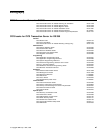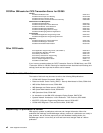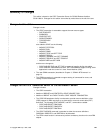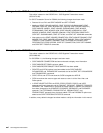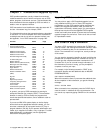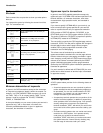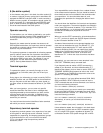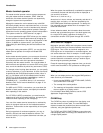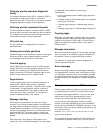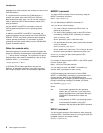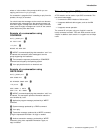introduction
| $ (the dollar symbol)
| In the character sets given in this book, the dollar symbol ($)
| is used as a national currency symbol and is assumed to be
| assigned the EBCDIC code point X'5B'. In some countries a
| different currency symbol, for example the pound symbol (£),
| or the yen symbol (¥), is assigned the same EBCDIC code
| point. In these countries, the appropriate currency symbol
| should be used instead of the dollar symbol.
Operator security
The transactions you can initiate are defined by your profile
in the external security manager (ESM) database, which is
normally provided when you sign on using the CESN
transaction.
Generally, the master terminal operator has access to all
CICS-supplied transactions, the supervisory terminal operator
has access to a subset, and the terminal operator has
access to very few transactions.
The system programmer is responsible for allocating operator
security codes to restrict the use of particular transactions.
For more information, see the relevant system administration
guide for the ESM you are using. For example, if you are
using RACF, see the
Resource Access Control Facility
(RACF): Security Administrator’s Guide
.
Terminal operator
To operate the system, you normally first sign on to the
system and, as a minimum, enter your user ID and your
password.
During signon, the information you enter is used by CICS to
establish priorities and your ESM profile for the transactions
that you may want to use later. When you have signed on,
you have access to those transactions defined in your ESM
profile.
After you have signed on, you can enter only specific
transaction identifiers. Be aware of error messages that
might be generated by the transactions you start, and the
corrective action that you must take. In addition to error
messages, be aware of other messages that CICS might
transmit to your terminal.
You need to know the terminal identifiers of other terminals
with which you want to communicate.
Supervisory terminal operator
A supervisory terminal operator is the supervisor of any part
of the system for which group control is desired. You are
responsible for supervising, and keeping operational, groups
of terminals defined in one or more terminal list tables
(TLTs). You do this using the supervisory terminal
transaction, CEST.
Your responsibilities can be thought of as a subset of those
of the master terminal operator, and you should be aware of
those functions that are not available to the terminals under
your supervision. You also should be aware of, and
understand, the procedure for changing the status of each
terminal.
You should know the identifiers of all terminals and operators
under your supervision. The terminal identifiers are defined in
one or more CICS terminal list tables (TLTs). Individual TLTs
can be identified by a 1-or 2-character suffix you enter as the
SUPRID and CLASS(value) keywords of the CEST
transaction.
When you use the CEST command for
all
terminals defined
in a TLT, you have to specify the SUPRID keyword followed
by the 2-character identifier of that TLT.
A subset of those terminals can be grouped together as a
class
, and can be defined as such in a different TLT. (For
information about defining the TLT itself, see the
CICS
Resource Definition Guide
.) You can specify that class by
means of the CLASS(value) keyword of the CEST SET
TERMINAL command, where ‘value’ is the suffix that
identifies the TLT in which the class of terminals has been
defined.
Alternatively, you can name one or more terminals in the
CEST SET TERMINAL(value) command itself.
If you frequently want to restrict a CEST command to a
subset of your terminals, and have defined another TLT
identifying that subset, you then have to use the CEST SET
TERMINAL SUPRID(value) keyword to refer to the “main”
TLT, followed by the CLASS(value) keyword to refer to the
specific TLT containing the subset.
So, for example, if you have defined terminals S202, S203,
S204, and S205 in DFHTLTAB and you want to issue a
CEST command that sets
all
those terminals out of service,
you issue the following command:
CEST SET TERMINAL SUPRID(AB) OUTSERVICE
If, on the other hand, you want to restrict your command(s)
to terminals S202 and S204, for example, you could define
these two terminals in another TLT—DFHTLTCD, say—and
issue the following command:
CEST SET TERMINAL SUPRID(AB) CLASS(CD) OUTSERVICE
Alternatively, of course, you could issue the following
command:
CEST SET TERMINAL(S22,S24) SUPRID(AB) OUTSERVICE
Unless otherwise stated, the information in this book about
the supervisory terminal and the CEST transaction applies
only to a single CICS system, regardless of whether it is
connected to another CICS system through ISC or MRO.
Chapter 1. Transactions supplied by CICS 3



